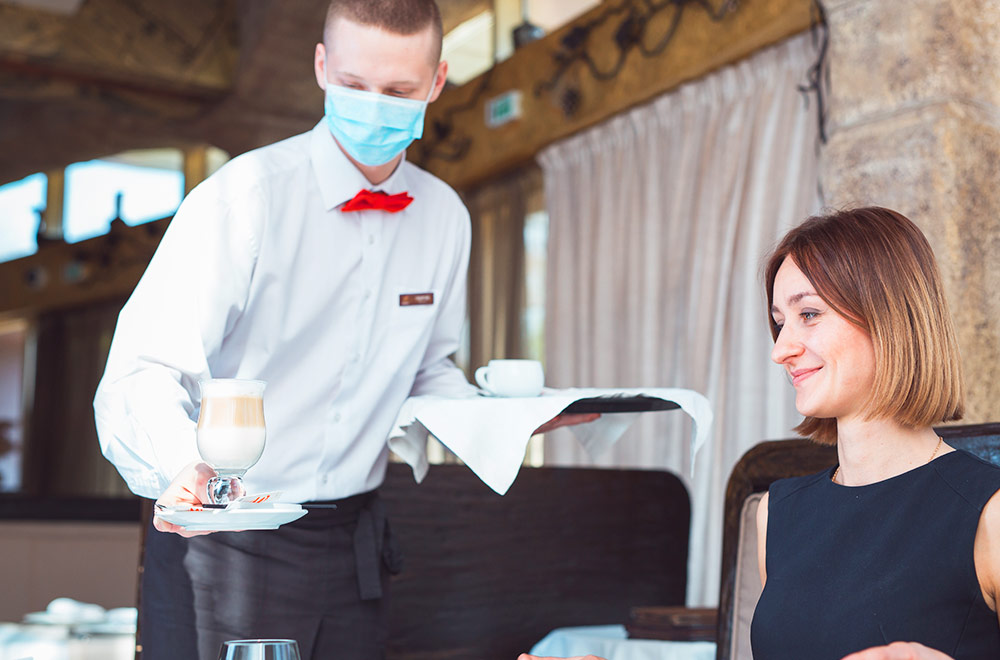Regional shelter-in-place restrictions are lifting, and restaurants are once again welcoming customers into their dining rooms and patios. Restaurants may be salivating over the return of dine-in revenue, but the competition for attracting guests during this transitional time will also pose new challenges. We recently conducted a survey of select members to gain a better understanding of consumer sentiment around dining out in the midst of—and in the wake of—the COVID-19 pandemic.
Our goal was to provide restaurants with valuable insight to help them alleviate potential customer concerns about a return to dining out. In order to be eligible to take the full survey, members needed to:
- Live in an area were restaurants were closed due to shelter-in-place orders, and;
- Have dined out at least once a month prior to the mass closing of restaurants.
After crunching the numbers, our main takeaways from the survey are this: people are social creatures who want to resume dining out in restaurants as soon as they feel safe doing so.
Timing and frequency
Sixty percent of survey respondents said that once dine-in restrictions are lifted, they’ll feel comfortable dining again immediately or within a few weeks at restaurants that are taking standard safety precautions (limited seating capacity, increased sanitation, socially distanced tables, servers wearing masks/gloves). In addition, another 23% said they would be ready one to two months after restrictions are lifted. This leaves 17% of respondents who won’t be ready to venture back into restaurants until three months or more after restrictions are lifted.
When asked how often they anticipate dining out now compared to before the pandemic, 64% of respondents said they will be dining out at the same frequency as before the pandemic. However, almost 29% say they believe they will dine in restaurants less frequently.
For those who plan on dining out less, just over two-thirds of respondents said it’s because of the risk of catching or spreading the virus.
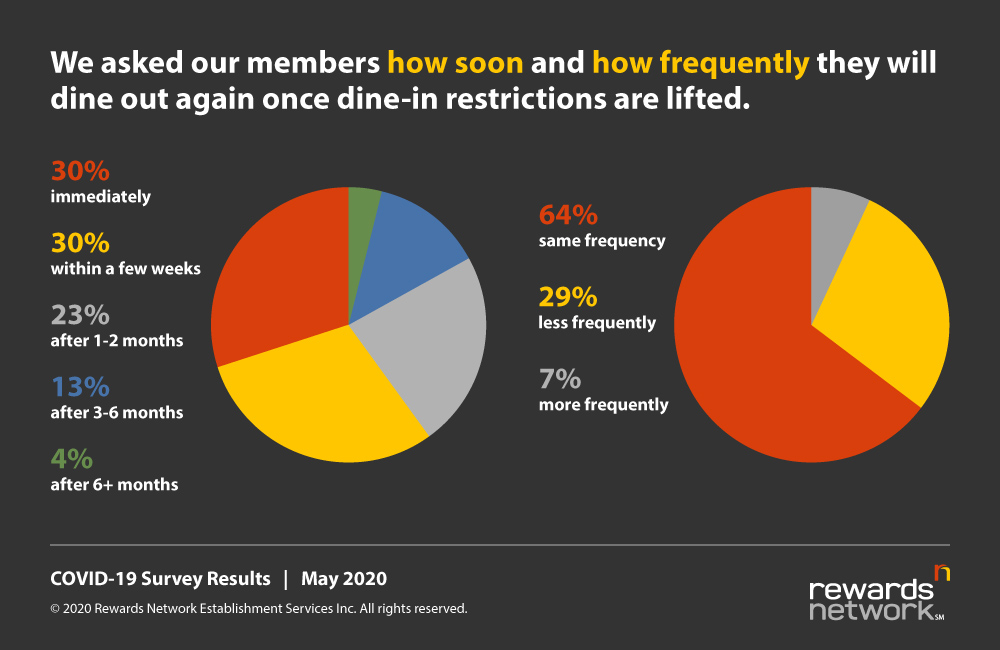
What it means for restaurants
The good news for restaurant owners is that the majority of guests anticipate being ready to dine out again shortly after restrictions are lifted. Since most restaurants will be operating at limited capacity, it appears there will be ample demand to fill available seats. If and when the virus dissipates, it’s likely that consumer sentiment around dining out will improve along with the easing of restaurant capacity restrictions. Ideally, this will result in an alignment of available seats and guest demand.
Taking (and publicizing) proactive steps to alleviate potential customer concerns about the safety may be the key to success for establishments for the foreseeable future. Restaurants can help ease concerns by following local public health and safety guidelines, and highlighting the specific precautions they are taking on their website, digital marketing channels, and with in-store signage.
Furthermore, with nearly one in 10 of respondents admitting a preference for takeout and delivery now, restaurant owners should incentivize guests to place an order directly from them, since orders placed with third-party delivery apps can prove costly for restaurants.
Health and safety
When asked what will represent the major turning point in their decision to dine out again, a combined 71% of respondents plan to rely on data, local ordinances, and guidance from health organizations. This includes:
- 26% who say they will dine out again when health authorities, such as the Centers for Disease Control or other government organizations, say it is OK to do so
- 25% when the data shows a flattening of the new cases curve
- 20% when shelter-in-place restrictions put in place by state and/or local governments are lifted
For 14% of respondents, the availability of a vaccine for the novel coronavirus will be the deciding factor in their decision to return to dining out, while 6% want to see testing become more widely available. Finally, 5% of respondents say they will be ready to dine out as soon as their family or friends start to do so.
Based on the survey results, it appears that most consumers won’t feel comfortable enjoying a night out until community and health guidelines say it’s safe to do so, and can present the data to back it up. Restaurant owners should keep a close eye on local reopening timelines—generally built around local infection data—to ensure they are taking the appropriate steps at the right time to reopen successfully.
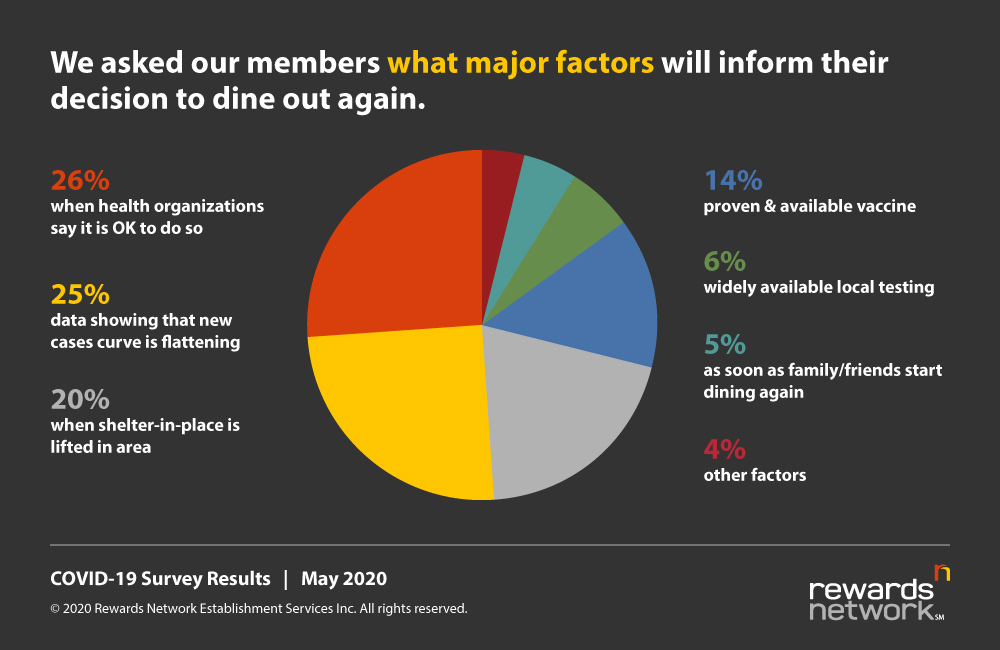
We also asked respondents which safety initiatives would factor most heavily in their decision to dine out again, and gave them the ability to select multiple answers. Socially distanced tables received the most votes, with 69% citing this as a prime concern. Frequent sanitization of surfaces was close behind, with nearly two thirds saying this would be a deciding factor, followed by the use of face masks and gloves by restaurant staff with 48%.
This shows that taking basic safety precautions in the dining room, such as socially distanced tables, frequently sanitizing, and mandatory masks and gloves for staff will likely be sufficient for the majority of guests to feel comfortable.
The availability of outdoor seating was also cited by more than a quarter of guests as something they are looking for when dining out. Restaurants that have an existing patio, or the ability to create one, should be able to benefit from this demand by appealing to not only sun seekers, but safety-conscious patrons. If you need some tips on sprucing up or creating an inviting patio space, check out the suggestions in our free e-book, “Get Your Restaurant Ready for Summer on a Budget.”
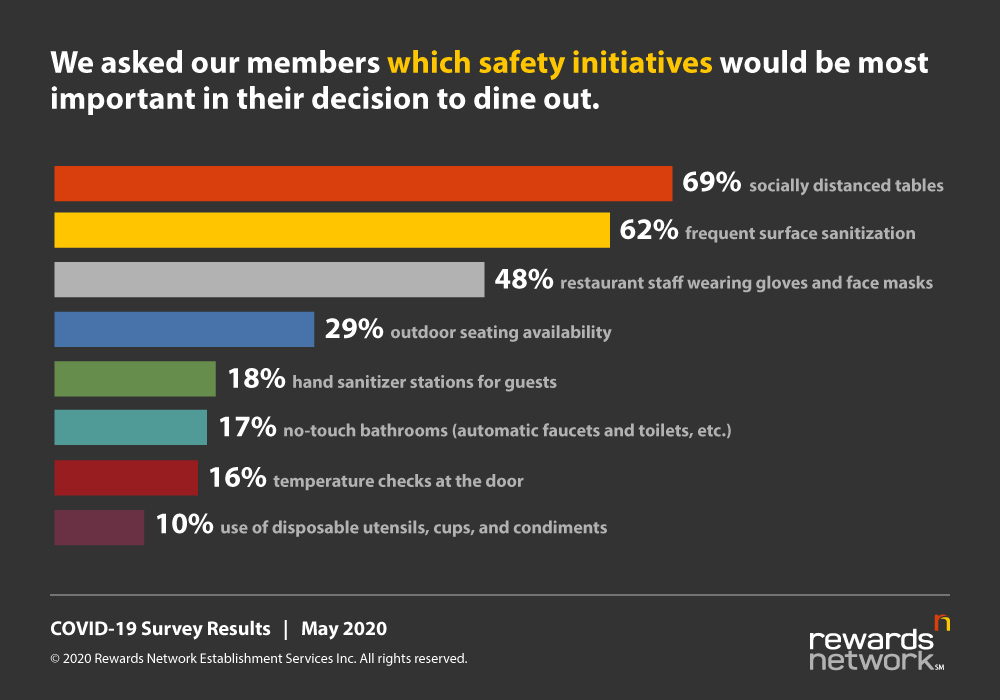
Dining preferences and socialization
Although there is the strong possibility that many restaurants won’t survive the crisis, consumers should still have plenty of choices when they feel ready to make the dining out leap. We asked survey takers which criteria they think will be the most influential when deciding which restaurant to dine at, with the option to choose multiple answers. The top choice was survey takers’ favorite place to dine pre-pandemic. More than two-thirds of respondents chose that option, which potentially indicates a desire to return to normal dining behavior.
The next three top vote-getters seem to be potentially more aligned with post-pandemic behavior. Almost two-thirds will seek out restaurants with the highest degree of cleanliness, close to half want to patronize restaurants that showed support for staff and the community during the pandemic, and almost a third will be looking for spots with the best prices, promotions, or rewards.
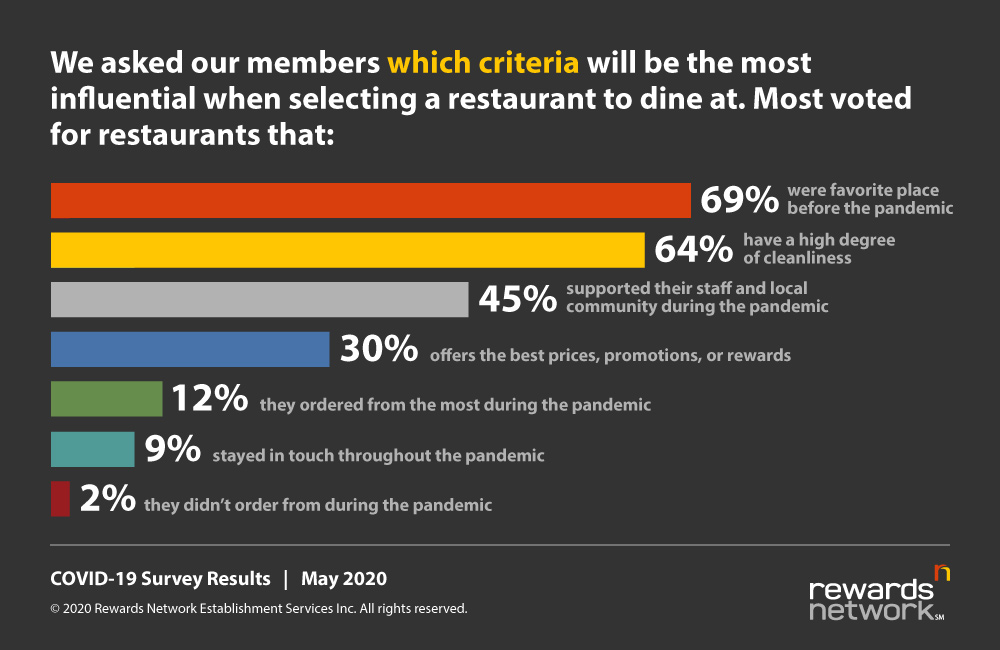
We also asked survey takers what they are looking forward to the most about dining out again. Given the current isolation situation, it’s not surprising that the leading answer was the social aspect, with 30% of respondents selecting this option. The other top three vote-getters include:
- Dining at my favorite restaurants: 29%
- Just getting out of the house: 25%
- Eating restaurant food: 11%
Six percent, likely those who are growing weary of the necessity of always serving as their own cook, waiter, and busser, cite being waited on as the restaurant experience they’re looking forward to with the most anticipation.
What it means for restaurants
It’s clear that consumers, as soon as they feel comfortable, will be more concerned about dining at their favorite restaurants than discounted pricing. Now is the time to get your loyal customers’ mouths watering at the thought of visiting your establishment. If you have a mailing list, send out emails/direct mail pieces alerting customers to when they will be able to dine in again, and include any changes in hours/reservations that you are implementing in the short-term. This information should also be posted on your website and social media channels.
In addition, you should highlight your health and safety initiatives, as well as any efforts you spearheaded to assist your employees and the community during the pandemic. People want to support businesses that care about and help others, even in the midst of a crisis.
Finally, tap into the pent-up demand among people to get out of the house and be social by promoting your bar or restaurant’s atmosphere and any special event nights, like trivia, to help consumers feel like they will get the most out of their potentially limited nights out by choosing your establishment.
Pricing, promos, and rewards
Some good news for restaurateurs is that based on the results of our survey, your guests won’t necessarily be looking for rock-bottom deals when choosing a restaurant. When asked how price-sensitive they expect to be when dining out now compared to before the pandemic, 74% of respondents said they will be just as price-sensitive, with only 18% saying more sensitive. And 8% think they will be less sensitive to prices. That’s good news for the restaurant owners that can win their business!
In addition, 54% of respondents aren’t expecting changes in the number of discounts or specials offered by restaurants, and 9% are expecting fewer. However, 37% do indicate that they expect a rise in special offers and discounts from restaurants as they reopen. While this could just be an assumption of how restaurants will plan on attracting customers, some may also be actively seeking out deals when choosing where to dine.
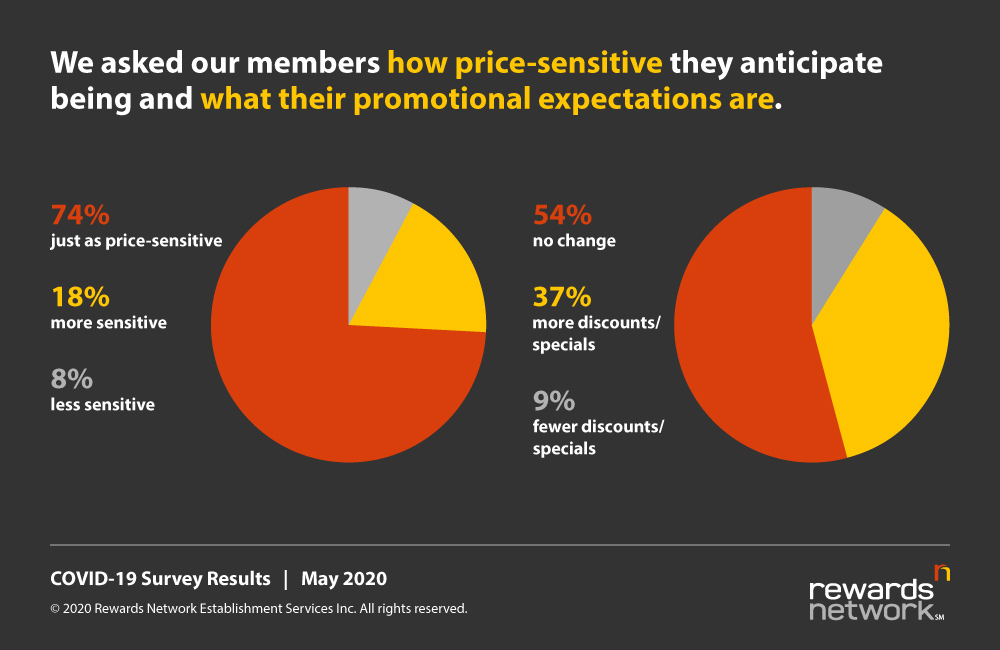
Finally, given that our survey takers are clearly interested in receiving rewards when they dine, we asked how important those rewards will be compared to before the crisis. Twenty-eight percent said it will be more important to receive rewards, while 66% say just as important as before, and 6% say less important.
What it means for restaurants
Although the majority of customers do not appear to be more price-sensitive, a large percentage of them are clearly expecting to see more discounts and promotions at restaurants. Whether or not that becomes a primary deciding factor when choosing a place to eat that isn’t one of their go-to favorites remains to be seen. However, restaurateurs may want to consider updating their menu to include less expensive options, and lowering the price on some higher-margin favorites and/or upselling select full-priced options.
Reward programs are another way to entice consumers to choose your restaurant over a competitor. You can either start your own to reward frequent diners, or partner with a proven company like Rewards Network that allows customers to earn rewards when they dine.
Conclusion
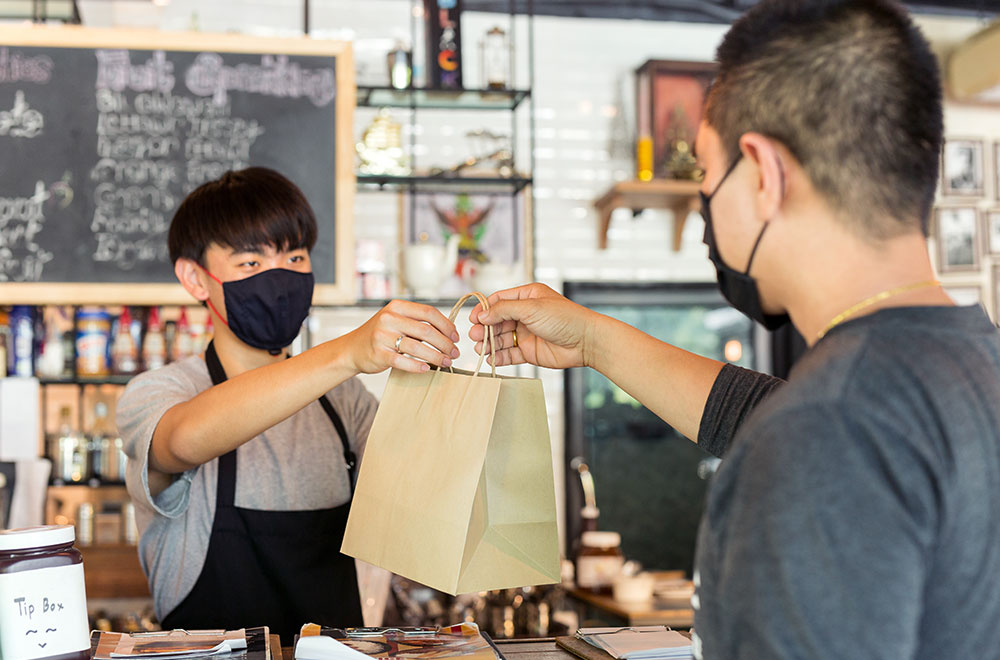
Our survey results point to a pent-up desire among consumers to resume dining out in restaurants shortly after restrictions are lifted. While demand will be initially dependent on health professionals’ guidance, restaurants taking the extra safety precautions and communicating them effectively to customers will be best-positioned for success in the near future.
Consumers may be dining less frequently (at least initially), but when they do, they are looking to eat at their favorite spots. Restaurants will want to ensure they communicate their reopening plans to loyal customers first and foremost. After guests dine, restaurants should be sure to inform them of other ways to enjoy their food and support them, such as ordering takeout directly from the restaurant or ordering delivery through the channel most profitable to the restaurant.
Price may not be the primary decision factor for consumers’ dining out choices, but offering specials, more affordable menu options, or rewards for dining could capture a necessary share of undecided diners. Furthermore, since customers are mostly looking forward to getting out of the house and connecting with one another, restaurants should be marketing the social experience they offer, perhaps by using imagery of happy customers and promoting themed nights.
Looking for more suggestions on navigating the current and post-COVID world? Be sure to browse our dedicated COVID-19 restaurant resource section and follow us on Twitter.
We conducted this survey of 1,373 members of AAdvantage DiningSM and MileagePlus DiningSM for approximately one week in mid-May. Members were awarded bonus miles for answering the survey questions honestly and completely. All of the information contained in this article summarizing the survey results is provided for informational purposes only and should not be construed as providing tax, legal, accounting, career, or other professional advice.
